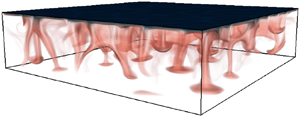Article contents
The cooling box problem: convection with a quadratic equation of state
Published online by Cambridge University Press: 06 May 2021
Abstract

We investigate the convective cooling of a fluid with a quadratic equation of state (EOS) by performing three-dimensional direct numerical simulations of a flow with a fixed top-boundary temperature, which is lower than the initial fluid temperature. We consider fluid temperatures near the density maximum, where the nonlinearity is expected to be important. When the EOS is nonlinear, the resultant vertical transport of heat is fundamentally different and significantly lower than the predictions derived for a linear EOS. Further, three dimensionless groups parameterise the convective system: the Rayleigh number ( ${Ra}_0$), the Prandtl number (Pr) and the dimensionless bottom water temperature
${Ra}_0$), the Prandtl number (Pr) and the dimensionless bottom water temperature  $(T_B)$. We further define an effective Rayleigh number (
$(T_B)$. We further define an effective Rayleigh number ( ${Ra}_{eff} = {Ra}_0 \ T_B^2$), which is equivalent to the traditional Rayleigh number used with a linear EOS. We present a predictive model for the vertical heat flux, the top boundary-layer thickness, and the turbulent kinetic energy (TKE) of the system. We show that this model agrees well with the direct numerical simulations. This model could be used to understand how quickly freshwater lakes cool in high-latitude environments.
${Ra}_{eff} = {Ra}_0 \ T_B^2$), which is equivalent to the traditional Rayleigh number used with a linear EOS. We present a predictive model for the vertical heat flux, the top boundary-layer thickness, and the turbulent kinetic energy (TKE) of the system. We show that this model agrees well with the direct numerical simulations. This model could be used to understand how quickly freshwater lakes cool in high-latitude environments.
JFM classification
Information
- Type
- JFM Papers
- Information
- Copyright
- © The Author(s), 2021. Published by Cambridge University Press
References
REFERENCES
- 9
- Cited by


